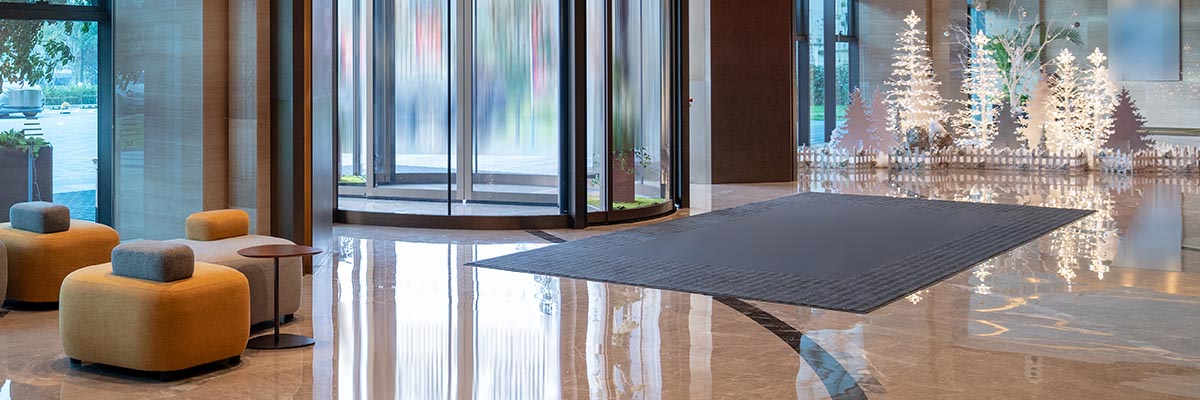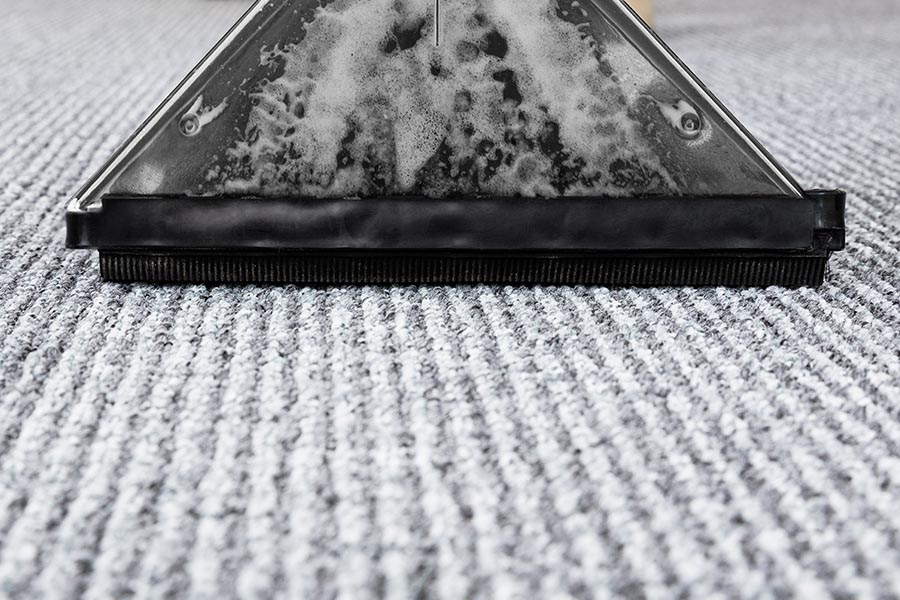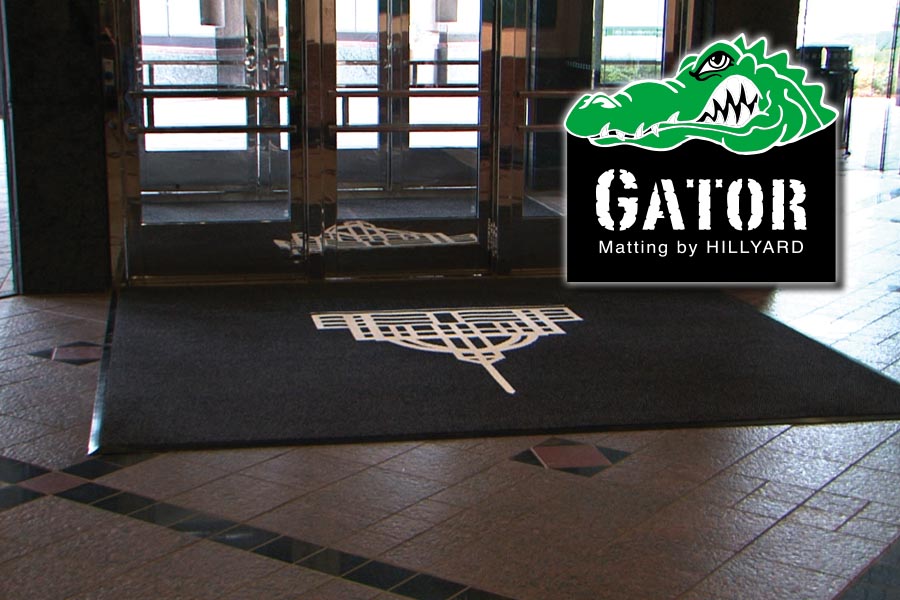Entry Matting: Trapping dirt to lower the total cost to clean
Entry matting, or walk-off matting, is crucial in maintaining a clean and safe environment in commercial buildings. High-quality matting solutions play a significant role in mitigating cleaning costs and maintaining the overall aesthetics of the building. Entrance mats effectively trap debris from shoes, preventing dirt and moisture from being tracked inside. Much of the wear of the floor finish comes from the abrasive nature of the soil brought in on the occupant's shoes. By trapping dirt as it enters the building, entry matting protects the floor finish in high-traffic areas.
This article will cover the key questions you should ask when purchasing entry matting.
- How long should an entry mat be?
- What factors should I consider when selecting an entrance mat system?
- What is the best way to maintain an entry mat?
- What can I do to find the best mats for my facility?

How long should an entry mat be?
The length of the mat used is of particular importance. Consider these two statistics. First, some studies estimate that occupants track in 85% of the dirt that enters a building. Second, another study showed that a twenty-foot entry mat can capture over 90% of the dirt brought in by the occupants. This means that the entry matting can significantly reduce the cost of cleaning the entire building.
Generally, we expect people to step on the mat once every three feet. The Carpet and Rug Institute provides some guidance regarding entrance mat length. For office buildings, the CRI recommends 12 to 15 feet. The recommended length for grocery stores or hospitals increases to 20 to 25 feet. So for effective cleaning, we want occupants to take between four and eight steps on the entry matting before entering the building.
Considerations When Choosing an Entry Matting Solution
When selecting a commercial matting solution for your facility, there are several key considerations to remember. These factors will help ensure that you choose the right matting solution that meets your specific needs and provides long-lasting performance.
Important Factors
- Foot traffic volume. Knowing how foot traffic varies through your entry points will help you decide the type of matting you should select for each. For high-traffic areas, a higher grade of carpet will perform better and withstand heavy use. You might find that you can reduce your budget by using a lower grade of entry mat for low-traffic areas.
- Budget. The lowest-cost solution may not always be the best. Typically, mat performance increases with the price. Higher-cost mats will generally have a higher face weight. The face weight determines how much dirt, debris, and moisture the mat can hold. If placed in a high-traffic area, lower-cost mats may not perform as needed, causing the overall cleaning cost to increase.
- Door clearance. While high face-weight mats excel in capturing dirt, it also has a higher thickness. Be sure to check your door clearance before purchasing a mat to ensure it will not interfere with the door's function.
- Appearance. Style and aesthetics are also important considerations, especially for buildings with a strong focus on design. Look for entry mats that come in a wide variety of colors and patterns to complement the overall aesthetic of your facility. To really tie the room together, you may want to add a logo or a school mascot with a custom inlay.
- Custom Size and Shape. Custom entrance mats can help maximize coverage and enhance aesthetics for some buildings. In addition, custom entry mats help improve the professional image of the building. Tailored to be precisely what you need, custom mats can align with traffic patterns to keep floors clean.
- Indoor or outdoor use. Determine whether the matting will be used indoors or outdoors. Different matting solutions are designed specifically for indoor or outdoor use, so it's essential to choose the appropriate option based on your specific needs.

Maintaining Entry Matting
Entrance mats can be divided into two categories: mats that are removed for cleaning and mats that are cleaned in place.
Clean-in-place (CIP) walk-off matting systems are generally heavier and better constructed than mats designed to be removed for cleaning. As a result, CIP mats will maintain their appearance and function longer. Maintaining a CIP mat is done through frequent vacuuming and periodic extraction.
Vacuuming should be done as often as necessary to maintain the mat's effectiveness. In most situations, once daily is sufficient. Because clean-in-place matting is heavier, you can quickly clean it with an upright vacuum. Removable mats are more difficult to vacuum, as their lightweight construction makes them prone to moving around during cleaning.
Extraction should be done with a self-contained carpet extraction machine, like the Trident EX7 or the Trident EX8. Depending on the outdoor conditions, monthly extraction may be all that is needed. More frequent cleaning will be needed in damp climates or during the winter. An air mover, like the Trident FD15, is recommended to reduce drying time.

Gator Matting by Hillyard
Gator Matting by Hillyard is a complete line of commercial clean-in-place walk-off mats.
Gator Entry Matting Features
- Heavy-duty high-face weight matting that can hold plenty of water and dirt.
- Ultra durable matting that won't curl on the edges or dog-ear. Reduces risk of tripping, compared to lower quality matting.
- A variety of colors, textures, and edge finishes.
- Custom shapes and inlay logos.
- Indoor and outdoor entrance mats.
Your local Hillyard representative can evaluate the current state of your floor care program, then make recommendations to improve your entry matting performance. Use the "I'm Interested" form below, and one of our representatives will contact you.
Frequently Asked Questions
What is entrance matting for?
Entrance mats'primary function is maintaining cleanliness and safety inside a building. The rest of the building stays cleaner by capturing dirt, debris, and moisture at the entry point.
How big should entrance matting be?
The correct size varies depending on factors such as foot traffic and weather conditions. For offices or commercial buildings, 12 to 15 feet is recommended. Between 20 and 25 feet is recommended for retail stores or healthcare facilities.
Is it better to have walk-off mats inside or outside?
The most effective approach is to have walk-off mats both inside and outside the building. Outdoor mats are the first line of defense and is generally designed to scrape larger particles off shoes. Indoor mats are designed to capture finer particles to remove residual moisture.
What is the difference between a wiper mat and a scraper mat?
Both are designed to remove dirt and moisture from shoes. Scraper mats are outdoor mats with features like groves, ridges, or bristles that scrape the pedestrian's shoes. Wiper mats are found indoors. They are typically more absorbent and are designed to capture fine dirt and residual moisture.